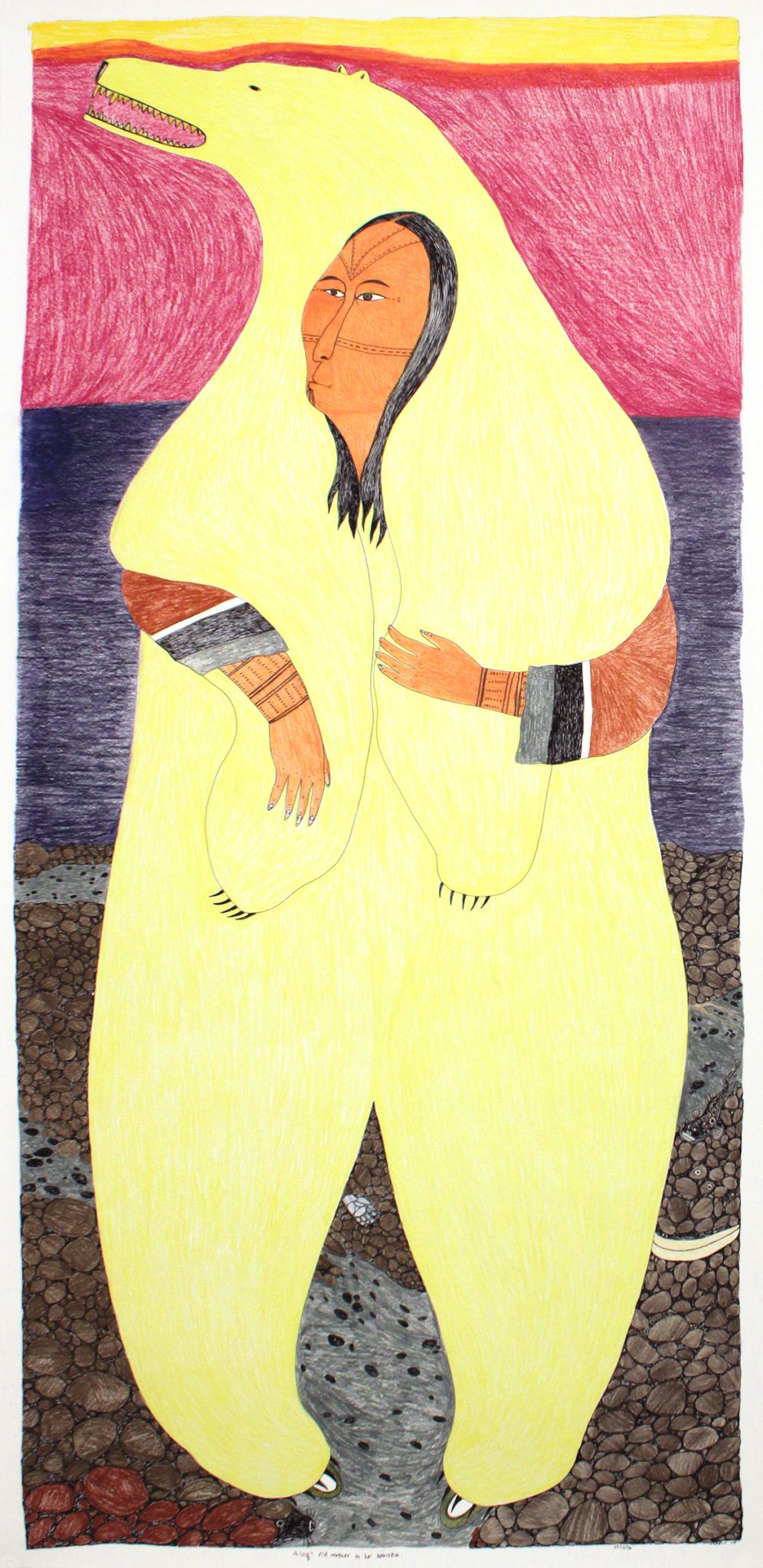
Ningiukulu Teevee, AILAQ’S OLD MOTHER IN HER BEARSKIN, 2016, Coloured pencil & ink, 48 x 24 in.
Exhibition opened May 21, 2016
It was Mother’s day when I reached Ningeokuluk Teevee in Iqaluit for our second interview. She was visiting her mother, Kanajuk, who is living at the Elders’ home. We naturally started off talking about our children and the joys and hard work of motherhood. Women feature prominently in Ningeokuluk’s drawings, so I asked her how she sees the lives of Inuit women today. “I grew up in a culture where women did all of the cooking, cleaning, sewing, taking care of children and men did the heavy stuff, it was just expected. I might have thought differently when I was younger, but that was the role we grew into.” Ningeokuluk has worked as a teacher, so I asked if she were teaching young Inuit women today, what would she teach them? “I want my granddaughter to be respectful so she’ll be respected,” she said. “I loved my grandmother very much and I always wished I could do more!”
Women also feature prominently in Inuit mythology, and these traditional stories have been a rich vein of inspiration for Ningeokuluk as an artist. Her interest dates back to her school days in Cape Dorset when she first heard them told by Mialia Jaw, a well-known local storyteller. Many of the drawings in this exhibition have been inspired by the book, Unikkaaqtuat: An Introduction to Inuit Myths and Legends (Neil Christopher, Noel McDermott and Louise Flaherty, eds., Iqaluit: Inhabit Media Inc., 2011). Published by Inhabit Media in Iqaluit, this is a wonderful compendium of 85 stories, intended – like all cultural myths – to enrich and enlighten, entertain and explain. Ningeokuluk can recount them with ease. “I love these stories,” she told me. “I have read them over and over again, trying to get a picture in my head. I am wearing them out!” “And then what will you do?”, I asked. “I try and see them from a different angle,” she said. “I would even like to see them in movies, with all the special effects, but told in the modern context, with all the things that are around us today. Then they might be seen by more people.”
Sharing these stories is an important motivation for Ningeokuluk, and highlights the enduring relevance of these myths. They serve many purposes but all people grapple with the fundamental mysteries of life and myths are one way of explaining the inexplicable. Myths are also important lessons about behavior and consequences. “These stories make you think,” Ningeokuluk believes. “A lot of them have consequences. Lumaajuuq is a really sad story. It makes me think, ‘Why did he do that to his mother?’ Revenge is never good.”
In closing, I asked Ning what she would like us – her audience – to take away from this exhibition and the myths and legends depicted in her drawings. “All these changes have happened in our lives,” she said. “I want them to know that we’re still Inuit who try and live with our same values. And our stories tie us to our past. I cannot tell them in Inuktitut the way they were told to me. Those storytellers have a special gift, because they also know all of the songs. There are not too many of them left.”
Ningeokuluk may not be able to tell the stories she loves so much but she has a very special gift for interpreting them as pictures. Through her talent and inventiveness she is transforming ancient cultural knowledge into some of the most contemporary and compelling work coming out of Cape Dorset today.
Leslie Boyd
To view available artworks by Ningiukulu Teevee, click here.
